Nyheter
David Hargreaves on Energy, week 51 2013
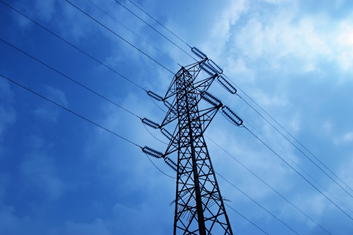
 Given we are in the grip of winter in the northern hemisphere, energy prices are not galloping north. Brent crude oil has far to go before WIM’s postulated $80/bbl. Uranium was moribund below $35/lb and thermal coal neither shaken nor stirred. The UK is at last warming to fracking and the International Energy Agency (IEA) blows hot and cold (mostly hot) on coal in its most recent report.
Given we are in the grip of winter in the northern hemisphere, energy prices are not galloping north. Brent crude oil has far to go before WIM’s postulated $80/bbl. Uranium was moribund below $35/lb and thermal coal neither shaken nor stirred. The UK is at last warming to fracking and the International Energy Agency (IEA) blows hot and cold (mostly hot) on coal in its most recent report.
Coal provides close on 30% of all the world’s primary energy needs, second only to oil and c.35%. So despite its environmental detractors, it is here to stay. Also, says the IEA, it is here to grow. As ever, it is the fault of the Chinese. Reasons for coal’s dominant position include: it is abundant and geopolitically secure and coal fired plants are easily integrated into existing power systems. So it will meet more of the projected energy-demand growth than either oil or gas. We read that:
Global Coal Consumption grew from 7.53bnt in 2011 to 7.70Bnt (+2.3%) in 2012. This was the third lowest growth on record in the past decade.
China posted its second lowest growth in the period (+4.7%) to an estimated 3.68bnt or 48% of world total. This dwarfs the demands of both Russia and the USA in met and thermal coal.
US Coal Demand fell 98Mt to c.822Mt. A mild winter, low gas prices and plant retirements were all cited. The country’s export capability increased accordingly. Demand also increased in OECD Europe (+17Mt) and OECD Asia and Oceania (+12Mt).
Global Coal Supply increased c.7.83Mt (+223Mt) mostly from China (+130Mt) and Indonesia (+82Mt) but declined strongly (-71Mt) in the USA.
Demand says the IEA, will grow at 2.3% per year through 2018, down on the actual of +3.4% per year in 2007-2012.
Coal Conversion Projects (eg to gas, fuel liquids) will continue apace, particularly in China. If this becomes prevalent, it will affect forecasts for natural oil, gas and shale gas projects. The demand from China will continue, fed in part by conversion.
Importantly, coal demand in the developed, ie OECD economies will not decline, but flatten. India’s position in the world coal market remains an enigma. It has huge reserves although of suspect quality whilst the dominant miner, Coal India Ltd (CIL), is arguably the world’s largest producer. Still the country is not only an importer but actively seeks overseas investments in the sector. It has a list of ‘captive’ mines, only allowed to sell into the controlled power station market, which does not take all their output but they are not allowed to sell on the open market.
WIM says: India’s aspirations to compete with China are self-defeating in all bar population, where its c.1.20bn people will over take China’s 1.3bn ere long. Otherwise, its minerals policies, including gold imports and reliance on foreign energy, are in a shambles. To compound this, the largely government owned CIL is eyeing five proposals to acquire assets in Indonesia. It is also sniffing around Mozambique’s Tete Province and South Africa’s Limpopo.
Malawi, the small, landlocked central African country, has a lone coal mine, Mchenga, in the north which is looking for a strategic partner to increase output. The coal is of relatively low industrial quality but has both local and export market potential.
One man’s corn…. The US has had a bumper corn harvest, reflected in low current prices. Increasingly, the crop is used to make ethanol which in turn is blended into biofuel to satisfy the green lobby. Then there are dried distillers grains, DDGs, also produced at ethanol plants, where profits, noted at up to $0.70-1.00 per gallon, are noted.
[hr]
About David Hargreaves
David Hargreaves is a mining engineer with over forty years of senior experience in the industry. After qualifying in coal mining he worked in the iron ore mines of Quebec and Northwest Ontario before diversifying into other bulk minerals including bauxite. He was Head of Research for stockbrokers James Capel in London from 1974 to 1977 and voted Mining Analyst of the year on three successive occasions.
Since forming his own metals broking and research company in 1977, he has successfully promoted and been a director of several public companies. He currently writes “The Week in Mining”, an incisive review of world mining events, for stockbrokers WH Ireland. David’s research pays particular attention to steel via the iron ore and coal supply industries. He is a Chartered Mining Engineer, Fellow of the Geological Society and the Institute of Mining, Minerals and Materials, and a Member of the Royal Institution. His textbook, “The World Index of Resources and Population” accurately predicted the exponential rise in demand for steel industry products.
Nyheter
Blykalla, Evroc och Studsvik vill bygga kärnkraftsdrivna datacenter i Sverige

Blykalla, Evroc och Studsvik har undertecknat ett samförståndsavtal för att undersöka möjligheten att utveckla Sveriges första kärnkraftsdrivna datacenter vid Studsviks licensierade kärnkraftsanläggning i Nyköping.
Blykalla utvecklar avancerade blykylda kärnreaktorer för att leverera säker, kostnadseffektiv och hållbar basenergi. Evroc bygger hyperscale-moln- och AI-infrastruktur för att driva Europas digitala framtid. Studsvik driver en licensierad kärnkraftsanläggning i Nyköping och tillhandahåller livscykeltjänster för kärnkraftssektorn, inklusive bränsle, material och avfallshantering. Tillsammans kombinerar de teknik, infrastruktur och anläggningsexpertis för att påskynda utbyggnaden av kärnkraftsdrivna datacenter.
Det finns en växande internationell efterfrågan på kärnkraftsdrivna datacenter, driven av parallella krav från AI och elektrifiering. Med sin kapacitet att leverera ren, pålitlig baskraft och inbyggd redundans är små modulära reaktorer särskilt väl lämpade för att möta detta behov.
Belastar inte elnätet
En stor fördel med att bygga datacenter och kärnkraftverk bredvid varandra är att elnätet inte belastas. Det gör totalpriset för elektriciteten blir lägre, samtidigt som det inte tillkommer investeringskostnader för operatören av elnätet.
Vill etablera Sverige som en föregångare
Med detta avtal strävar parterna efter att etablera Sverige som en föregångare i denna globala omställning, genom att utnyttja Studsviks licensierade anläggning, Evrocs digitala infrastruktur och Blykallas avancerade SMR-teknik.
”Detta samarbete är en möjlighet för Sverige att bli ledande inom digital infrastruktur. Det ger oss möjlighet att visa hur små modulära reaktorer kan tillhandahålla den stabila, fossilfria energi som krävs för AI-revolutionen”, säger Jacob Stedman, vd för Blykalla. ”Studsviks anläggning och evrocs ambitioner erbjuder rätt förutsättningar för ett banbrytande projekt.”
Samförståndsavtalet fastställer en ram för samarbete mellan de tre parterna. Målet är att utvärdera den kommersiella och tekniska genomförbarheten av att samlokalisera datacenter och SMR på Studsviks licensierade anläggning, samarbeta med kommuner och markägare samt definiera hur en framtida kommersiell struktur för elköpsavtal skulle kunna se ut.
”Den ständigt växande efterfrågan på AI understryker det akuta behovet av att snabbt bygga ut en massiv hyperskalig AI-infrastruktur. Genom vårt samarbete med Blykalla och Studsvik utforskar vi en modell där Sverige kan ta ledningen i byggandet av en klimatneutral digital infrastruktur”, kommenterar Mattias Åström, grundare och VD för Evroc.
”Studsvik erbjuder en unik plattform med anläggningsinfrastruktur och unik kompetens för att kombinera avancerad kärnkraft med nästa generations industri. Detta samförståndsavtal är ett viktigt steg för att utvärdera hur sådana synergier kan realiseras i Sverige”, kommenterar Karl Thedéen, vd för Studsvik.
Parterna kommer nu att inrätta en gemensam styrgrupp för att utvärdera anläggningen och affärsmodellen, med målet att inleda formella partnerskapsförhandlingar senare i år. Deras fortsatta samarbete ska möjliggöra ren och säker energi för Europas AI-infrastruktur och digitala infrastruktur.
Nyheter
Toppmöte om framtidens kärnkraft runt Östersjön hölls idag

Sveriges regering arrangerade på tisdagen ett toppmöte om framtidens kärnkraft i Östersjöregionen tillsammans med Finland. Ministrar från Polen, Lettland och Estland deltog, liksom investerare, banker och kärnkraftsbolag. EFN:s reporter Thomas Arnroth rapporterar från mötet.
Energi- och näringsminister Ebba Busch betonade att målet är att göra Sverige till regionens ledande kärnkraftsnation och en hub för kärnkraft i Östersjöområdet.
Tanken är att länderna ska samarbeta och se regionen som en gemensam marknad, vilket kan påskynda och sänka kostnaderna för nya reaktorer. Kunskap kan användas gemensamt över hela regionen och en reaktortyp skulle bara behöva godkännas en gång.
Nyheter
Nytt prisrekord, guld stiger över 4000 USD

Priset på guld på CME-börsen steg precis för första gången någonsin över 4000 USD per uns. Detta efter att både investerare och centralbanker söker en trygg hamn, om än av delvis olika orsaker. Vi har tidigare idag rapporterat att Goldman Sachs skruvat upp sin guldprognos för slutet av 2026 till 4900 USD per uns.

-

 Nyheter4 veckor sedan
Nyheter4 veckor sedanMahvie Minerals i en guldtrend
-

 Analys4 veckor sedan
Analys4 veckor sedanVolatile but going nowhere. Brent crude circles USD 66 as market weighs surplus vs risk
-
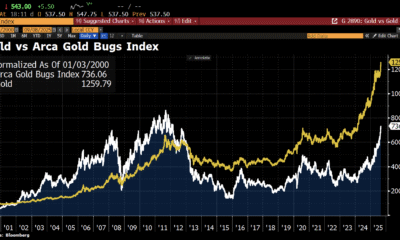
 Nyheter4 veckor sedan
Nyheter4 veckor sedanAktier i guldbolag laggar priset på guld
-
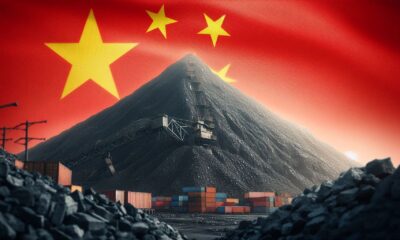
 Nyheter3 veckor sedan
Nyheter3 veckor sedanKinas elproduktion slog nytt rekord i augusti, vilket även kolkraft gjorde
-

 Nyheter3 veckor sedan
Nyheter3 veckor sedanTyskland har så höga elpriser att företag inte har råd att använda elektricitet
-
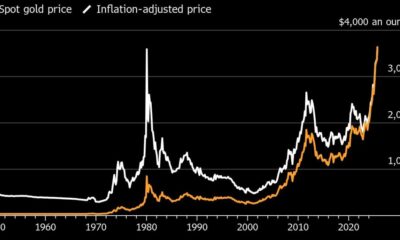
 Nyheter4 veckor sedan
Nyheter4 veckor sedanGuld når sin högsta nivå någonsin, nu även justerat för inflation
-
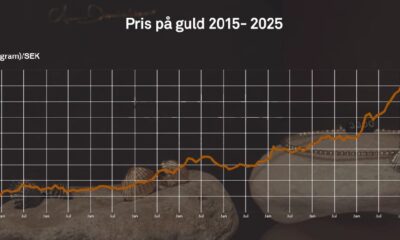
 Nyheter4 veckor sedan
Nyheter4 veckor sedanDet stigande guldpriset en utmaning för smyckesköpare
-

 Analys4 veckor sedan
Analys4 veckor sedanWaiting for the surplus while we worry about Israel and Qatar












